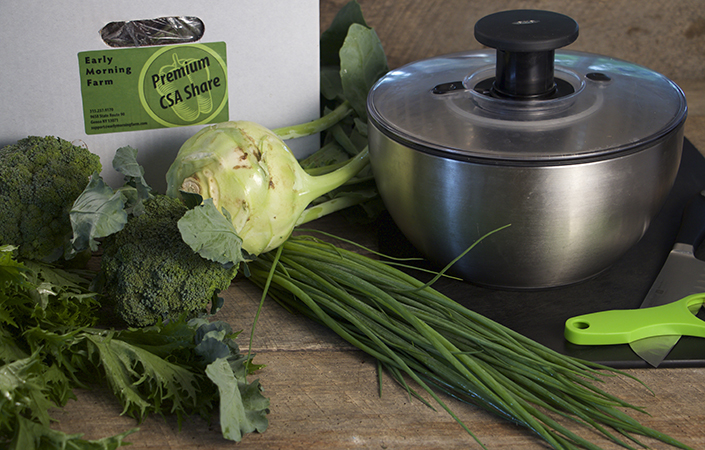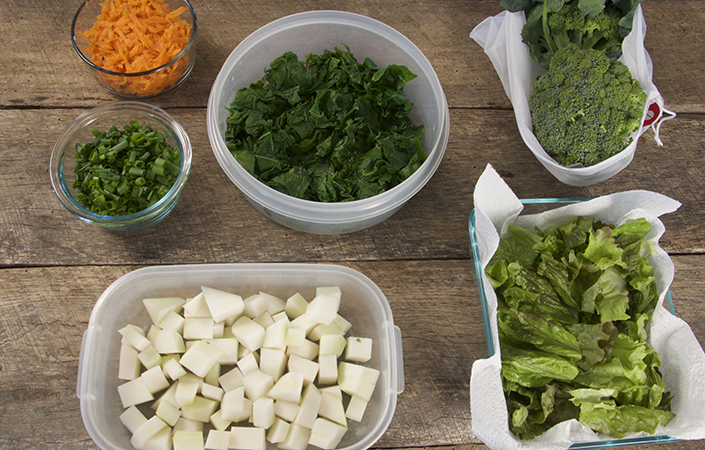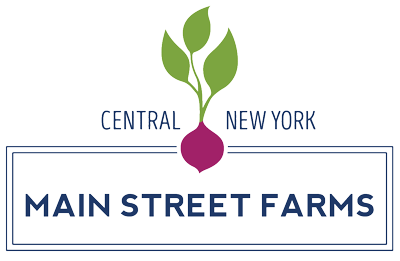
Joining a CSA is a win-win for farmers and community members. Farmers get to stabilize their income, crop planning, and go into the farming season with a community of members to feed and interact with each week. CSA members get a steady stream of vegetables at a great price and often organically grown (our CSA is certified organic). Whether you’ve been a CSA member for years or are just starting out, a little planning ahead (and the willingness to share!) is all you need to make the most out of your abundant greens, roots, herbs, and more this summer. Here’s our top ten list, let us know if you have any tips in the comments!
1. Be Prepared. As soon as you get your box (or a day or two later) spend less than an hour pre-prepping your vegetables. This investment is more than worth it. Get out a cutting board, sharp knife, and salad spinner. Wash and dry your lettuce, then store it a lidded container lined with a paper towel. Peel and dice anything that will hold well, like kohlrabi, beets, carrots. Blanch greens and stick them in the freezer. Even if you plan on using them later in the week, it’s so easy to get them on the table when all you need to do is toss them in a pan with olive oil and garlic. Grate roots for tossing in salads or making quick fritters. When everything is ready to go you’ll eat healthier meals fast. Today I didn’t have time to make lunch so I grabbed a prepped container of lettuce, local bread, pesto, and pickled vegetables. Lunch was delicious and easy!

2. Shake up a classic. Try a Kale Caesar Salad or a Bok Choy Wedge. Throw some kale in a classic mac and cheese, or put roasted vegetables on a pizza. Swap out lettuce for any of the greens in your CSA, don’t be afraid to try something new!
3. Pickle. Whenever my beets are piling up I grab a few quart jars and pickle them. It’s a tasty snack and kids love them! Our basic pickling liquid pretty much never changes, 1 cup water, 1/2 cup vinegar, 3 tablespoons sweetener, and 1 teaspoon of salt. Add herbs or whole spices if you like! So far we’ve tried turnips, carrots, onions, radishes, eggs….The characters of Portlandia are definitely on to something!
4. Make Pesto. This is my favorite and most delicious way to preserve greens. In the beginning of the CSA season you might find your self with many bundles of greens, most of which can be made into pesto! Pesto stores great in the freezer, and you’ll be so happy to find a container in the back of your refrigerator during the dark days of winter. Check out our pesto tab for recipes.
5. Make latkes or fritters. If you pre-grate vegetables like we mentioned above, you can quickly make shredded vegetable pancakes even the pickiest eaters will love. I like to serve mine with a creamy aioli or yogurt dip spiked with whatever fresh herbs I have on hand. Try summer squash, celeriac, carrots, radishes, beets, butternut squash – anything you can grate! Check our archives for inspiration.
6. Smoothies. Here’s another great way to sneak some greens into your picky eaters. Throw a handful of chopped kale, chard, spinach, or anything else into a smoothie. You can also use blanched frozen greens if you have them. Get creative with combinations! I like berries, yogurt, banana, and greens. Mangoes, pineapple, and even avocados can go in smoothies. Here’s fun green smoothie and berry based.
7. Eat salad for dinner. Salad does not have to be an after thought! When your share box has an abundance of lettuce make a satisfying salad with grilled protein, homemade dressing, nut or seeds, and local cheese. Try wrapping up your dinner in crunchy lettuce wraps – perfect for pesto, hummus, grain salads, tacos, and more. Lettuce wraps are great for gluten free or paleo guests too!
8. Be a hoarder. Our CSA boxes come with a vented plastic bag that’s perfect for storing extra produce. After a few weeks you’ll have more than enough to sort your root vegetables into bags and save them if you can’t get to them. Keep one for carrots, one for beets, one for greens, etc. Root vegetables stored this way stay fresh for months and you’ll be glad to have some left when then CSA season starts!
9. Store herbs properly. Huge bundles of herbs can be intimidating, but you can make the most of your herbs and even save some to enjoy later. Store fresh herbs like you would a bouquet of flowers, then cover the whole thing with a plastic bag and wrap a rubberband around the jar. Stored this way, herbs can last up to 3 weeks! Try freezing herbs in water or olive oil in an ice cube tray, they will be a gem in the winter!
10. Eat root to stem. Locavores and farmers have been touting eat “tail to snout” for years, but right now eating the whole vegetable is the latest trend. Sauté radish greens or add them to a salad. Add onion skins to homemade cooking stock, make pesto with carrot tops, eat your turnip greens, and get creative!


